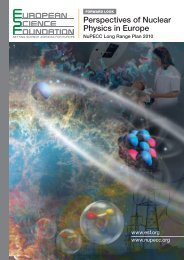Vol. 21 No. 1 - NuPECC
Vol. 21 No. 1 - NuPECC
Vol. 21 No. 1 - NuPECC
Create successful ePaper yourself
Turn your PDF publications into a flip-book with our unique Google optimized e-Paper software.
editorial<br />
<strong>NuPECC</strong> Long Range Plan 2010—Perspectives<br />
of Nuclear Physics in Europe<br />
As announced in the April–June<br />
2009 issue of the Nuclear Physics<br />
News International, the Nuclear Physics<br />
European Collaboration Committee<br />
of the European Science Foundation<br />
have now published their Forward<br />
Look on Nuclear Physics in Europe at<br />
a Presentation Conference in Brussels<br />
(under the Belgian EU Presidency) on<br />
9 December 2010.<br />
The goal of the <strong>NuPECC</strong> Long<br />
Range Plan 2010 was to bring together<br />
the entire Nuclear Physics community<br />
in Europe to formulate a coherent plan<br />
of the best way to develop the field in<br />
the coming decade and beyond.<br />
Nuclear Physics projects are often<br />
“big science,” which implies large<br />
investments and long lead times. They<br />
need careful forward planning and<br />
strong support from policymakers.<br />
The Long Range Plan 2010 provides<br />
an excellent tool to achieve this. It<br />
represents the outcome of detailed<br />
scrutiny by Europe’s leading experts<br />
and will help focus the views of the<br />
scientific community on the most<br />
promising directions in the field and<br />
create the basis for funding agencies<br />
to provide adequate support.<br />
The full Long Range Plan 2010 can<br />
be found at http://www.nupecc.org/,<br />
together with a booklet and a video<br />
that presents the case to the educated<br />
public. The report is based on the work<br />
of six expert sub-committees in the<br />
fields of Hadron Physics, Phases of<br />
Strongly Interacting Matter, Nuclear<br />
Structure and Dynamics, Fundamental<br />
Interactions, and Nuclear Physics<br />
Tools and Applications.<br />
The main outcome of the exercise<br />
was a list of recommendations grouped<br />
under seven headers and shown below<br />
in an abbreviated version.<br />
ESFRI Facilities<br />
Complete in a timely fashion the<br />
construction of the nuclear physics<br />
facilities on the ESFRI list of largescale<br />
research infrastructure projects<br />
in Europe:<br />
a. FAIR at the GSI site, including its<br />
four pillars, the PANDA antiproton<br />
experiment, the NuSTAR<br />
radioactive ion beam (RIB) facility,<br />
the CBM dense baryonic matter<br />
experiment, and the atomic,<br />
plasma, and applied physics program<br />
APPA.<br />
b. SPIRAL2 at GANIL, including<br />
high-intensity stable ion beams<br />
and ISOL RIBs to study exotic<br />
nuclei.<br />
Major Upgrades<br />
Carry out major upgrades of the<br />
following complementary large-scale<br />
nuclear physics facilities:<br />
Figure 1. Roadmap for Nuclear Physics research infrastructure in Europe.<br />
a. HIE-ISOLDE at CERN (RIBs).<br />
b. SPES at INFN-LNL (RIBs).<br />
c. The AGATA γ-ray detector to be<br />
used at the above facilities.<br />
The views expressed here do not represent the views and policies of <strong>NuPECC</strong> except where explicitly identified.<br />
<strong>Vol</strong>. <strong>21</strong>, <strong>No</strong>. 1, 2011, Nuclear Physics News 3
















